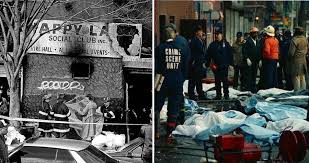On a tragic night in 1990, an arsonist set a massive fire at the Happy Land Social Club in the Bronx, trapping 93 young people inside.
In the early hours of March 25, 1990, a rejected lover approached the entrance of the Bronx’s Happy Land Social Club. Using two matches and a dollar’s worth of gasoline, he ignited a fire at the door, one of the few exits available to the young people inside. What started as a night of fun quickly turned into horror. Within minutes, 87 people were dead. Only six survived.
“This is the worst thing I have seen in my career. It was sickening,” said EMS specialist Christopher McCarthy, who was at the scene that night. “I saw wall-to-wall bodies — an indication of mass confusion and panic.”
This is the tragic story of the Happy Land fire.
How The Happy Land Fire Killed 87 People In Minutes
On that fateful March evening, a crowd of young people, mostly Hondurans and mostly under 25, gathered at the Happy Land Social Club in the Bronx. “Most of the bodies were in dance clothes,” McCarthy recalled. “They were out to have fun.”
The club was operating illegally, without sprinklers, and several exits had been blocked to conceal the party inside.
Ruben Valladares, one of the few survivors, was the DJ that night. As the crowd danced, he played a mix of merengue, salsa, reggae, and calypso records. Everything seemed normal until panicked shouts interrupted the music.
Felipe Figueroa, a patron at the club, heard people screaming, “Fire! Fire!” Seeing smoke, Figueroa ran down the stairs and was one of the few who escaped.
“I heard a lot of people screaming,” Valladares recalled. “When I ran to the door, I called everybody: I said, ‘If someone’s going to leave, follow me.’” Valladares managed to escape, but he was badly burned. “When I left, I was on fire. All over my body.”
Firefighters arrived about three minutes later. EMS Lt. Roy David saw Valladares stagger out of the burning building, his clothes stuck to his burned skin. He couldn’t talk. The ambulance report noted burn injuries across his entire body.
The 150 firefighters at the scene extinguished the Happy Land fire in five minutes, but it was too late. “There was one in the street telling us there were loads of people inside, trapped,” said Dennis Devlin, one of the first firefighters to arrive. “We couldn’t hear anybody screaming or yelling. There was no one hollering.”
Nearly all the victims, 61 men and 26 women, died from smoke inhalation, though some were killed in the chaotic rush to the only door. Seven victims were from the same family, six were trampled at the door, and many others were found locked in embraces, under tables, or behind the bar.
The Man Who Started The Fire Receives A Life Sentence For Every Victim
It was quickly discovered that the fire had been deliberately set by 36-year-old Julio González. Earlier that evening, González had an argument with his girlfriend, Lydia Feliciano, a ticket-taker and coat checker at the club. After being thrown out by a bouncer, González sought revenge.
Figueroa recalled that about 20 minutes before the fire, “A man said to the guy at the door, ‘You’re going to pay for it.’” González bought a dollar’s worth of gasoline at a nearby Amoco station and returned to the nightclub. He poured the gasoline at the entrance of the Happy Land Social Club and set it alight with two matches. Police arrested González the next morning at his apartment, which smelled of gasoline. He quickly confessed, although initially claiming, “The devil made me do it.” Officer Michael Geary reported that González felt he needed to pay for what he did.
Julio González was sentenced to 87 concurrent terms of 25 years to life. “It wasn’t enough; I wanted the death sentence,” said Maria Colon, the wife of one of the victims. González died of a heart attack in 2016 at the age of 61.
The Happy Land Fire Forces The City To Strengthen Its Fire Safety Codes
The arsonist wasn’t the only one at fault for the devastating Happy Land fire. Investigators also had to address why 87 victims were unable to escape. The club lacked proper exits and lighting, had sprinklers only on the upper story, and no fire alarms. These violations had led to a city order for the club owner, Elias Colon, to vacate the premises in 1989. Colon died in the fire.
Building owner Jay Weiss and landlord Alex DiLorenzo III pleaded guilty to these violations and were sentenced to community service and fined $150,000, which was paid toward a community center in the Bronx. They also settled with the victims’ families for $15.8 million.
Following the tragedy, then-Mayor David Dinkins ordered a task force to inspect the city’s 227 active clubs. The New York City Department of Buildings also increased investigations into illegal clubs, checking the 1,250 sites believed to be defunct.
“Now there’s a citywide task force that ensures that Happy Lands are not all over our city,” said New York Fire Department Commissioner Daniel Nigro, who was a battalion chief in 1990. “Endangering people who may want to go out and have a good time and end up never coming home.”
These changes, while not undoing the tragedy, bring some peace to the horrifying story of the Happy Land fire.
Now that you’ve learned about the Happy Land fire, read about more unforgettable fire tragedies in history, like the great Chicago fire of 1871 and the Dublin whiskey fire of 1875.
